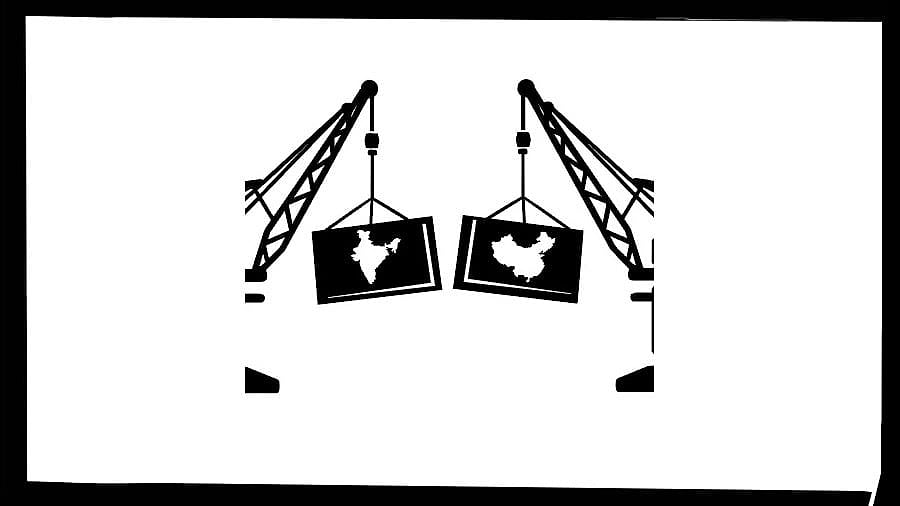
DH Illustration
Trade, considered a key engine of growth, has seen significant advances in recent years due to technological upgrades, improved transport and communication, liberalisation, and expanded global supply chains, facilitating faster and efficient cross-border exchanges. Besides growth, trade is expected to have a far-reaching influence on various parameters of economic development.
However, this rapid expansion has come with environmental costs. The drivers that have fuelled global trade – transportation, industrial production, and resource extraction – have increased carbon emissions, degraded natural habitats, and depleted natural resources. These issues are notable in emerging economies like India and China, where the pursuit of economic growth and global trade integration often conflicts with environmental protection.
As economic ties between the two nations deepen, a concerning pattern has emerged over the past three decades: China’s demand is higher for pollution-intensive products, and India is a major supplier of such products to China. It raises questions about whether India is inadvertently becoming a pollution haven in bilateral trade, potentially compromising its environmental integrity for economic gains.
India’s exports to China largely comprise products from polluting industries. Between 1992 and 2024, India’s total exports of pollution-intensive goods surged from $7.49 billion to $221.11 billion, with shipments to China rising sharply from $0.14 billion to $6.97 billion. While overall imports of such goods also rose – from $16.02 billion to $358.03 billion – India’s imports from China jumped from $0.07 billion to $31.17 billion.
Notably, the share of these goods in India’s exports to China increased from less than 1% to over 50%, while imports of these products from China grew from 0.50% to 25%. Key Indian exports include mining products, iron and steel, chemicals, non-ferrous metals, and petroleum products, while major imports from China span chemicals, pulp and paper, automobiles, non-ferrous metals, food products, and pharmaceuticals.
The fact that over half of India’s exports to China now come from pollution-intensive industries, while only a fraction of China’s exports to India fall in this category, reflects not just economic choices, but a broader global trend – where countries with stricter environmental regulations like China outsource their pollution-intensive production to partners with lax rules.
As China tightens environmental regulations and enforcement and shifts to cleaner industries, India, with weaker regulatory enforcement, absorbs the environmental fallout.
India’s carbon and emission intensity remain higher than China’s, providing an incentive and opportunity for China to shift pollution offshore without shifting actual factories. India’s weak institutional capacity to enforce regulations made it vulnerable to becoming a pollution haven. The result is rising trade, but at a growing ecological cost to India. This shifting of pollution within the Global South complicates environmental injustice narratives, requiring us to rethink not only who pollutes, but also who pays the price in a world of decentralised and competitive global supply chains.
The pollution haven hypothesis describes the North-South trade dynamic, where developed countries outsource pollution to developing nations. However, the India-China trade dynamic represents a different pattern. Rather than the traditional “rich country pollutes poor country” narrative, it shows a hierarchy within the Global South, where powerful emerging economies use trade leverage to externalise environmental costs to weaker peers who often prioritise economic growth over environmental protection.
Among developing countries, economically stronger nations like China often shift harmful production towards relatively less developed nations in Asia or Africa due to differences in regulatory stringency, enforcement capacity, and economic power. Weaker nations accept it due to economic incentives, lack of alternatives or poor governance. Between India and China, India increasingly finds itself on the losing side, creating a pattern where environmental costs shift laterally across developing countries rather than vertically from developed ones.
An imbalanced partnership
Such a trade pattern has several non-economic consequences. While India gains a surge in export volume, it also accumulates pollution, resource depletion, land degradation, and associated health risks – a comparative advantage with severe long-term and hidden economic and environmental costs. Without stringent environmental regulations, India’s comparative advantage could turn into a long-term disadvantage, disrupting environmental quality and obstructing the attainment of sustainable development goals. The sectors in which India has a proven export strength, such as chemicals, petroleum refining, and mining and ore beneficiation are highly pollution-intensive, questioning the sustainability of such a growth model.
With increasing global demand for environmental initiatives, India’s status as a pollution haven raises concern. As economic giants, India and China significantly influence the region’s environmental trajectory through their trade interactions. This trade relationship has become alarmingly imbalanced, with India, perhaps unknowingly, serving as a pollution haven for China. Without immediate action, India may end up paying the price for China’s cleaner future.
The policymakers should focus on cleaner technologies, stricter enforcement of environmental standards, collaboration on green initiatives, innovations, and technology transfer. A win-win is possible if both countries adopt cleaner production methods, keeping the trade equation unaltered and not sacrificing environmental quality.
Economic development and environmental sustainability are closely linked and not mutually exclusive. Inaction towards cleaner production and trade could make India a pollution haven not only for China but for the world.
(Malini is an associate professor at ISEC; Varadurga is an assistant
professor at R V University)